Caitlin Doughty's Blog, page 32
March 2, 2017
Why Are You Afraid of Death?
March 1, 2017
CALENDAR OF EVENTS – Spring 2017
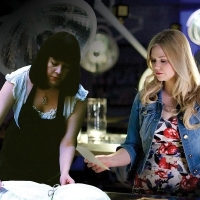 CAITLIN DOUGHTY
CAITLIN DOUGHTY
Doctors’ Orders for a Good Death: Caitlin Doughty and Dr. Lindsey Fitzharris, April 6th, Los Angeles
UNDERTAKING LA

Undertaking LA morticians Caitlin Doughty and Amber Carvaly host death care workshops in Los Angeles. If you are interested in attending please sign up for the Undertaking LA mailing list by following the instructions outlined here. You can read a bit more about the workshops in Taking Care Of The Dead At Home, And Other Matters Of Mortality on LAist.
 DEATH SALON
DEATH SALONDeath Salon is the event series of The Order, that brings together independent thinkers engaged in the exploration of our shared mortality by sharing knowledge and art. Our next Death Salon will take place in Seattle, September 8-10, 2017. To be notified of programming, ticket sales and updates visit the Death Salon website or sign up for our mailing list.
 SAVE THE DATE
SAVE THE DATE The Order’s sister site, Death & the Maiden will be hosting their first conference in July at the University of Winchester. Caitlin Doughty will be a keynote speaker and numerous Order members will be participating. There will be talks, field trips, workshops and performances. Want to participate or attend? Check out the conference website for details.
ORDER OF THE GOOD DEATH MEMBERS

Artwork by Order member, Landis Blair
Dr. Lindsey Fitzharris in conversation with Caitlin Doughty in Doctors’ Orders for a Good Death. This event will be moderated by Megan Rosenbloom on April 6th in Los Angeles.
Joanna Ebenstein will be speaking with Chris McCreary in Ars Moriendi: Visions of Death Made Beautiful on April 8th in Philadelphia.
Nora Menkin will be at The People’s Memorial Annual Meeting on April 22nd, in Seattle.
Landis Blair will have a table in Artist’s Alley at C2E2 comic con, April 21-23 in Chicago.
Katrina Spade will be participating in Reviving the Environment: Ways to Honor the Dead and Living, on April 27th in San Francisco.
OTHER DEATH POSITIVE EVENTS

Tracing the Remains is an exhibit that explores transformations of the living body and its decay post mortem. Exhibit runs through July 6th in Philadelphia.
Mountain View Cemetery Tour. Explore the crypts, hallways filled with stained-glass, and tranquil gardens. March 5th in Los Angeles.
Rat Taxidermy with Afterlife Anatomy Learn the principles and techniques of contemporary ethically-sourced taxidermy practice, as you complete your own beautiful piece of taxidermy. On March 5th in Brooklyn.
Designing Death: Challenges and Aesthetics for the 21st Century will address questions about whether current aesthetics and rituals still speak to our contemporary understanding of death. March 15th, London.
French & Mottershead: Afterlife offers a meditative self portrait of what happens to our bodies after death. Various dates throughout March in Manchester.
How Do We Live with Death Festival this multi-day festival explores our relationship to death and mortality though a series of lectures, performances and much more.
Life, Death and the Rest is an event series at Arnos Vale Cemetery. Unique offerings such as a story time for children, a steampunk exhibit on Spiritualism, bespoke poetry and a screening of death positive film, Harold and Maude with Lucy Coleman Talbot. March 30-April 2, Bristol.
Centre for Death and Society Seminar : Terror Management Theory. Come learn about Terror Management Theory, the philosophy that inspires our work here at The Order on May 4th in Bath.
February 25, 2017
WHEN CORPSES & SKULLS WERE MEDICINE
February 16, 2017
Do Crows Have Funerals?
February 15, 2017
Plot E
I have visited many American military cemeteries over the years, and I have always found them to be beautiful and humbling places. They are quiet and dignified edens wherein lie the honored dead who have defended the nation.
There is one cemetery, though, that doesn’t quite live up to this archetype.
Plot E of the Oise-Aisne American cemetery in northern France.
Go ahead and look. You won’t find it listed on the Veterans Administration website, nor any of the literature provided by the cemetery. Maps will show Plots A, B, C, and D only, those containing 6012 American dead from WWI. Google Earth will just show an expanse of green. It’s like it doesn’t exist, which is exactly what its creators intended.
But it’s very much there, and serves a necessary if somewhat unsavory purpose.
Plot E is where American servicemen are buried who were executed – by firing squad or hanging – for capital crimes committed in the European theatre during or shortly after WWII. Some of the victims were children. Many were women. Most are forgotten by the modern age, though at least one – Sir Eric Teichman, killed on his ancestral estate confronting two U.S. soldiers poaching on the land – was a prominent member of society who still has his own Wikipedia page.
Those capital crimes once included aggravated rape, murder, and desertion, though currently none interred in Plot E are deserters. More on that in a moment.
Plot E is located 100 meters from the main cemetery, and contains the remains of 94 servicemen. It is across a small road and deliberately hidden from view by a tall border of hedgerows that surrounds the 90′ x 50′ oval space. Because of the dense shrubbery, and the fact that there is no path nor gate, the only access to the area is through the back door of the cemetery superintendent’s office… and this is highly discouraged. There are no gravestones, nor any plaques with names – the graves are designated by white index-card sized stone markers with stark black numbers, in four rows, and all facing away from the recognized burial ground nearby. Plot E has been described by one cemetery employee as a “house of shame” and “the perfect anti-memorial,” esp as the original intent was that none of the individual remains were ever to be identifiable by name (it was only after a Freedom of Information lawsuit in 2009 that a list of grave numbers and occupants was released to the public). No U.S. flag is allowed to fly there, although there is a single small granite cross to one side. Nevertheless, it is maintained, with grass being cut and hedges trimmed, perhaps more for the aesthetic sensibilities of the superintendent than due to any niceties afforded the deceased.
Originally, the 98 condemned by the U.S. Army following general courts martial were buried near the sites of their executions, which took place at locations as far-flung as England, France, Belgium, Germany, Italy, and Algeria. In 1949, however, it was decided to relocate all such remains to a single venue; that site is described by the Graves Registration as being for “the dishonored dead,” since, according to protocol, all had been dishonorably discharged from the service just prior to execution.
For reasons unclear, two of those executed during the 1940s never were sent to Plot E. Two others were buried there but later exhumed and returned to the United States. One of those was Private Alex F. Miranda, who came back to the U.S. in 1990, though details of the transfer were never made public.
The second was the former occupant of Row 3, #65, Private Eddie Slovik, the only man executed during WWII for desertion. His later became a cause celebre, as other soldiers deserted during the war, but Eisenhower decided to make a sole example of the rough street kid from Detroit on 31 January 1945. His remains were finally returned to the U.S. on order of President Reagan in 1987, and rest today at Woodmere Cemetery in the city of his birth, next to the grave of his wife.
Order-member John Carbone is a forensic psychiatrist and former Director of Mental Health Services for the North Carolina prison system. You can also find his words at Alienist’s Compendium.
February 9, 2017
ASK A MORTICIAN – All About Cremation!
February 8, 2017
The Twisted Tale of Winnie Ruth Judd: Phoenix’s Favorite Murderess
In November of 2016 I had a chance to visit the former house of famed Phoenix, Arizona “murderess”, Winnie Ruth Judd. Some people call it the “death house” or “murder house”.
It’s a weird sight. Dwarfed by tall, gleaming corporate buildings and construction, the house looks out of time and out of place. A somber little purple-gray cottage with cracking walls, sitting on a bare, sandy lot enclosed by chain link fence, a person would be hard-pressed to walk by the property and not ask, “What happened here?”
Of course if you’re from Phoenix you probably already know. More so, you might even feel some cultural pride about the house’s history.
Standing obstinately in its lot for close to 100 years (and counting, thanks to a private owner with plans to preserve it), the house is something of an enduring homage to the woman who made it famous. Despite being touched by death, the community is not repelled by the house or the deadly circumstances surrounding it, instead they find it “unifying”.
Scott Coblio
“If it happens in Phoenix, they’re proud of it,” jokes filmmaker, author, and Winnie Ruth Judd historian, Scott Coblio. I recently had the opportunity to spend an afternoon chatting with Coblio, picking his brain about the more morbid details of Winnie’s case, as well as why he thinks people respond so strongly to her.
Coblio devoted much of his life to untangling the events leading to Winnie killing two women– Agnes “Anne” LeRoi and Sarah Hedvig “Sammy” Samuelson. He says Phoenicians see Winnie and the deaths as part of the fabric of Phoenix culture and history. Death touched Phoenix, and Phoenix embraced it.
“Winnie was appealing. People were struck by how resilient she was. You didn’t know if she was hiding this monstrous dark side, or if she was the victim or the villain,” says Coblio. “She was feisty when oppressed.”
There’s no avoiding the macabre details of the case, but make no mistake, this is not just one more tasteless stop not the “dark tourism” highway. Somehow Winnie, in her flawed, twisted vivacity (The Velvet Tigress! The Blonde Butcher!) is the Phoenix death icon that appeals to both people’s sense of horror and humanity.
But what actually did happen? It’s not entirely clear.
“We still don’t 100 percent know [what happened] because she made three different confessions that are all diametrically opposed to each other. Each under legal advisement and, I assume, all strategic,” says Coblio.
However, after poring over police reports, Winnie’s confessions, letters, newspaper coverage, and writings by other “Winnie Ruth Judd theorists”, Coblio has a reasonable idea as to what happened on the night of the murders, and beyond. Coblio says the timeline of events, as he understands it, closely follows “Winnie’s version” of the story.
Girls Night Gone Bad
On Friday Oct. 16, 1931, Winnie Ruth Judd was at the Grunow Medical Clinic where she worked as a secretary, when her friend, coworker, and former roommate Anne, invited her over to her house that night. Anne said another friend was coming over, and maybe they could all play cards.
Winnie declined at first, but Anne persisted. Anne LeRoi lived with Hedvig “Sammy” Samuelson in a cottage on the corner of 2nd Street and Catalina Drive in Phoenix. Winnie, Anne, and Sammy had formerly all lived together in the house, but due to differences between the three women (READ: A MAN) Winnie had moved out a week prior.
“At this point there’s a lot of tension and strain between these three women,” Coblio explains. “Winnie had been writing her husband [struggling with morphine addiction in Santa Monica, California] all week complaining about Anne. She felt like she was ‘going crazy’ and Anne was making her crazy.” So things were not warm and fuzzy between Winnie, Anne, and Sammy.
Winnie decided that she was going to see her boyfriend, Jack Halloran that night instead. Halloran was a central figure in Winnie’s case. A popular, wealthy businessman in Phoenix, everybody knew who Jack Holloran was, and everybody liked him. Jack especially liked the ladies.
Jack was tangled up in Anne, Sammy, and Winnie’s lives. The women were deeply dependent on him, financially and emotionally. “He was their meal ticket,” says Coblio. More than that, they each felt rather possessive of Jack’s attention. But it seems that Winnie was the one with whom which Jack had the closest relationship. At least, as far as Winnie knew.
Winnie called Jack after work that night and he said that he’d come over to her apartment around eight or nine o’clock. Nine o’clock came and went, and no Jack. Winnie was pissed.
“So around 10 o’clock she left her apartment and went to Anne and Sammy’s house. They told Winnie, ‘Why don’t you stay the night with us?’”
Winnie agreed to stay, and the gals sat around in the back bedroom gabbing over cups of rice pudding (allegedly – it’s not entirely clear what the pre-murder snack of choice was). At one point in the night Anne asked Winnie, “How did it ever come about that Jack met Lucille Moore?” Anne and Sammy had recently seen Jack, Winnie, and Lucille spending time together, and they were none too pleased. It was believed that Lucille was being treated for syphilis. Scandal!
So the women began arguing about Jack, Lucille, and the syphilis. Winnie argued that professionally she couldn’t divulge Lucille’s medical history to Jack, and besides Lucille and Jack were just friends.
Anne and Sammycalled BS on this, and Anne threatened to tell Jack about Lucille’s SYPHILIS.
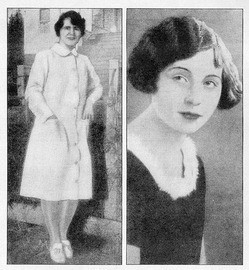
Anne and Sammy. Photograph via Philip Warbasse
Not to be bullied, Winnie countered that if they divulged the SYPHILIS, then she’d tell everyone that the rumors of Anne and Sammy’s LESBIANISM were true! More scandal!
With those words, Winnie got up and took her cup of (alleged) rice pudding back to the kitchen down the hallway. There was (and still is) a breakfast room “which had a separate doorway that you can enter through from the living room”. Keep this layout in mind.
“According to Winnie, Sammy came running into the breakfast room with a gun and said, ‘If you tell anything about Anne at the clinic, I’ll shoot you sure!’”
The gun in question was Winnie’s. “It was supposedly left behind from when Winnie lived there with them. She had only moved out a week ago, so it is possible that she left the gun behind. If Winnie went to [Anne and Sammy’s] house with a gun, that casts more light of suspicion on her. Even I’m not sure,” says Coblio.
Regardless, Winnie and Sammy start wrestling for the gun. As they wrestled, Anne came running out of the bedroom with an ironing board that she proceeded to beat Winnie with. As Anne beat Winnie with the ironing board, she shouted, “Shoot her Sammy! Shoot!”
Picture this just for a moment: Winnie, Sammy, and Anne are in their pajamas. Sammy and Winnie are wrestling for a gun, while a screaming Anne beats Winnie over the head with an ironing board (the ironing board beating was supported by evidence, as “when [Winnie] turned herself in a week later, she had in excess of 100 bruises on her body”).
What do you do at your slumber parties?
In the struggle for the gun, Winnie got shot in the hand – but Sammy got shot in the chest. Finding herself in possession of the gun, Winnie turned and shot Anne. Remember this is Winnie’s telling of the events.
Winnie quickly got dressed and ran out of the house, back to her apartment, with the intention of calling her husband for help. But before she could do that, good ol’ “Happy” Jack Halloran showed up drunk. Winnie frantically told Jack what happened but he was like, “No way!” And Winnie was like, “Way!” (official case transcript…in my head) and dragged him back to the death house.
You know what they say about returning to the scene of the crime.
Have Corpse, Will Travel
“Back at the house, the girls were still lying on the floor. The first thing Jack did was turn off the lights, close the curtains, check their pulses, and pick up Sammy and put her on a bed. Sammy’s the only one he seemed concerned about.”
As Winnie cleaned up the house Jack told her, “For God sake, don’t call your husband! Don’t call the police! Do you know what this means to you and me if you tell anyone about his? Leave everything to me.”
He then told Winnie to get the steamer trunk from the garage. “We’ll put the bodies in that, and I”ll bring them out to the desert.”
Jack told her to go to work the next day and act like she didn’t just kill her former roommates, and wait for a call from Jack. Winnie did as she was told, rattled, frightened, and still with a bullet in her bandaged hand.
Finally Jack called, telling her “I was unable to take care of those parties as planned. You’re going to have to take them on the train to L.A. I’ll have a man named Mr. Wilson waiting to meet you and together he’ll drive you to the beach,” where the bodies would be disposed of. While this exchange cannot be 100% proven, if it did transpire as Winnie claims it did, Halloran may very well have been setting Winnie up. “Jack Halloran has to know this is a terrible plan,” says Coblio.
After work Winnie went back to Anne and Sammy’s house to take care of the bodies. The delivery man was met with a strange sight. “She’s standing in the dark [in the house], next to this trunk, and she says, ‘I’m sorry, but I have to transact our business by the list of candles. The electricity has been turned off as we are moving.’” Winnie really tried to play it cool, she really did.
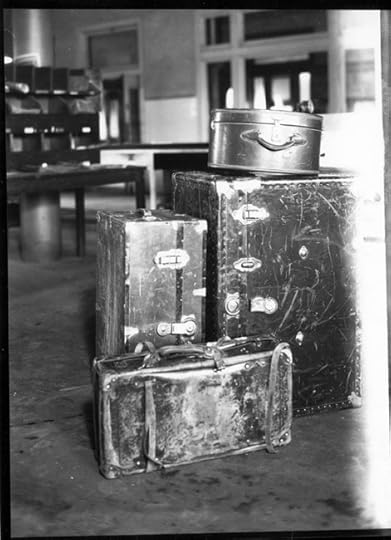
The trunks and luggage that held the dead bodies. Arizona Historical Society/Winnie Ruth Judd Collection
But then – you guessed it – she flipped on a light switch.
Illumination faux pas aside, the delivery man told Winnie that the trunk she wanted him to deliver to the train station (the trunk containing the bodies of Anne and Sammy) was over the weight limit and she’d have to pay extra. Lacking the funds, she told the delivery service to take the trunk to her apartment. With Jack not returning her calls, Winnie had to take matters into her own hands.
“So it’s Saturday night, she’s alone with this trunk, and she has the mastermind plan to separate the contents of the single trunk into a number of pieces of luggage so no one piece will be over the weight limit.”
Either the women were immediately shoved in the trunk or, as a Dr. Wagner stated during Winnie’s trial, Sammy was immediately dismembered – at least one to nine hours after death – and put in the trunk. Winnie and Jack may have waited too long and rigor mortis had set in, forcing them to dismember Sammy at the house.
There’s also some question as how pliable (if she was intact) Sammy was once Winnie decided to chop her up. Winnie was small woman who had been plagued with tuberculosis throughout her life. Could she really have moved and chopped a rigid corpse all by herself? Let alone efficiently?
The scenario that is largely agreed upon is that if Anne and Sammy were killed around 6am on Saturday morning, the corpses could have speedily been put in the trunk before full rigor set in, and by the time Winnie starting splitting Sammy between her luggage, in the early hours of Sunday morning, rigor would have broken and she would have been soft enough for Winnie to manipulate and move “inch by inch” as she said.
Winnie distributed Sammy’s corpse between several smaller pieces of luggage: a smaller trunk, a suitcase, and a hat box.
According to Coblio, Anne got to stay in the big trunk and the bulk of Sammy’s body was split between the smaller trunk and the suitcase. Additionally, Winnie filled her luggage with “personal letters”, evidence that could convict her, because she was so confident that everything would be disposed of in Los Angeles.
Winnie took the train to Los Angeles, a day later than planned. There was no mysterious Mr. Wilson upon her arrival, but she’d arranged for her brother to pick her up.
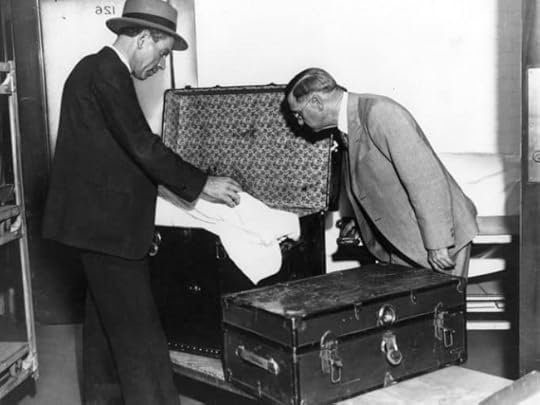
However, there was a problem with her luggage. Imagine that. It seemed the trunks were leaking a foul smelling liquid, along with something that appeared to be blood. PRO TIP: chopped up, three day old bodies are going to ooze more than the allotted fluids you’re allowed to travel with – plan accordingly!
When the officials at the train station asked her for the key to open her luggage in order to examine it, she simply said she didn’t have the key and walked out.
Winnie briefly spoke with her brother before disappearing into Los Angeles for a week. Coblio says she seemed to have a “cloak of invisibility”. Walking all over Los Angeles, and all the way to Pasadena, Winnie laid low and took refuge where she could. And this was all with a hand slowly turning gangrenous from the bullet still lodged in it. You can’t say that Winnie wasn’t scrappy.
One of her hideouts was La Vina Sanatarium in Altadena where she had been a tuberculosis patient years earlier. “She found a vacant cottage there and slept for two days.” (Scrappy.)
But Winnie’s story was the talk of the Los Angeles area. Winnie heard people talking about her, talking about her husband, and speculating about her whereabouts. At one point she heard someone reading a newspaper article aloud (perhaps for her benefit?) about how her husband wanted her to turn herself in and HERE’S THE NUMBER TO CALL, WINNIE.
“So she called [the number] and her husband sent a guy to pick her up. They brought her to a funeral home, the Alvarez & Moore Funeral Chapel” where Winnie was reunited with her husband, William C. Judd, before turning herself into the police.
Winnie was mobbed by photographers on the steps of the funeral home wearing a fur coat she’d stolen from La Vena Sanatarium. She was “ultra glamorous, beautiful…very cinematic,” said Coblio.
America began a twisted love affair with Winnie Ruth Judd, the Trunk Murderess.
The Trial
Winnie’s trial began on January 19, 1932 at the Maricopa Courthouse in Phoenix. Initially she was “being tried for only the murder of one of the girls, Anne. [Her defense] thought [Sammy’s] ‘dismemberment issue’ would be too incriminating. If she was found innocent for the death of Anne, they were going to try her again for the death of Sammy.”
Interestingly enough, every member of the jury was asked if they knew Jack Halloran, but it was never clarified why exactly they were asked this. Halloran was also present at the trial everyday, but never spoke on the record, and was never called as a witness.
Amidst all the hubbub, William Randolph Hearst – yes, that William Randolph Hearst – got involved and put “$20,000 in a defense fund for her. So she fires her lawyer and gets a hot shot lawyer who won’t let her speak, and they have this very unconvincing insanity trial.” (It’s speculated that Hearst and Winnie had an agreement: her “exclusive” life story – which she did write for him – in exchange for the money. Plus of course, Winnie’s trial was selling loads of papers for him.)
The prosecution went after Winnie on premeditated murder charges, saying her self-defense wounds were self inflicted. Winnie’s trial was a circus. Evidence was not always reliable, her confession was questionable, and the press ran rampant. The press was there taking notes when Winnie had surgery to take the bullet out of her gangrenous hand, she started speaking in her gas-induced stupor, saying things like, “I had to fight them…you’d have fought too…I fought so hard.”
On February 8, 1932 Winnie was found guilty and sentenced to die by hanging on February 17, 1933, Good Friday. But finally Winnie had had it. She told her lawyers she wanted to talk, that Jack Halloran had told her to exonerate him. He said that if she agreed, she wouldn’t be sent to prison or, you know, EXECUTED.
Jack Halloran was indicted for a preliminary hearing to determine if he should be tried as an accomplice to murder. At the hearing Winnie spoke at length, famously stating, “I am going to be hanged for something Jack Halloran is responsible for…I was convicted of murder, but I shot in self-defense. Jack Halloran removed every bit of evidence. He is responsible for me going through all this. He is guilty of anything I am guilty of.”
The judge and jury agreed that it was not homicide, but self-defense. Happy Jack got to walk free, but Winnie did not, despite this trial’s ruling in her favor. Her death sentence did not change. However, “In the 11th hour the, sheriff of the jail where she was being held, found a really antiquated loophole wherein if he personally thinks she’s insane, he can request an insanity hearing for her. So he uses the loophole.”
Winnie writes yet another confession, this one ranting and raving, possibly coached for the purpose of receiving the insanity trial. In it, she tells a drastically different story of going to the house with the gun, how her dependency on the drug Luminal was making her “crazy”, and that she acted alone. She got the insanity hearing, however the verdict had to be handed down in her favor before the day of her execution, otherwise she’d still hang.
HORRIBLE ARIZONA HANGING FACT: The only woman to be executed by hanging was Eva Dugan in 1930. Something went wrong, and her head came off. You heard me.
With only hours to spare, Winnie Ruth Judd was declared insane and sent to Arizona State Hospital where she could stay “with the stipulation that if she was ever to be rehabilitated and found sane, she must immediately be hanged.”
Life After Deaths
Winnie lived at the hospital for 40 years, escaping at least six times. You see, the nurses were so fond of Winnie that they gave her a key to the front door of the hospital. They never even changed the locks after her escapes. Winnie was very popular, and even became a sought-after hair stylist. “She started doing finger waves for the women in the hospital to make them feel better about themselves. Soon it became fashionable for society people to go have their hair done by Winnie at the state hospital.”
The longest of her escapes lasted six years. Yes, that’s correct six human years. During her six-year absence from the hospital, Winnie became the nurse to a wealthy woman in California who came to really love her, and willed to her a huge some of money as well as “a house on her property” upon her death. Unfortunately Winnie’s nephew, who was blackmailing her “threatening to turn her in if she didn’t give him her paycheck”, did just that and the police arrived at the rich lady’s house to take Winnie away. So back she went to the state hospital.
But luck was on Winnie’s side. Lawyers Larry DeBus of Phoenix and Melvin Belli of California worked together to get Winnie paroled in 1971. After over 40 years living “under the shadow of the noose”, Winnie was free.
***
And that, Deathlings, is the long, twisted tale of Winnie Ruth Judd. Was she guilty? Was she innocent? Was she something in-between? Was her entire life simply a struggle to survive? The world may never know, Winnie made sure of that.
However, Winnie ignited something in the Phoenix community. The idea that death can be a part of a culture but not necessarily darken it. One could argue that folks are looking at the murders through rose-colored glasses, but I find it remarkable that there isn’t an obscene or exploitative feel to the speculation.
In fact, talking with Scott Coblio about Winnie was oddly uplifting; we found ourselves tossing around words like “spunky”, “survivor”, and “complex heroine”.
Yes there is a morbid fascination with Anne, Sammy, Jack, and Winnie, but it seems to be genuine wonder and curiosity about what really happened. Death is part of the cultural conversation. You can’t look at the case of Winnie Ruth Judd, look at the deaths of Anne and Sammy, without looking at death; without considering what happened to their corpses, what the reality of that was. But Phoenix does not seem fazed by it. In the preservation of Winnie’s story, the house, Halloran’s house, and the ongoing interest in the case, Phoenix seems at peace, even proud, with how death exists in their history.
Louise Hung is an American writer living in Japan. You may remember her from xoJane’s Creepy Corner, Global Comment, or from one of her many articles on death, folklore, or cats floating around the Internet. Follow her on Twitter.
Thank you to Scott Coblio for talking with me about Winnie Ruth Judd. Interested in reading more of Scott’s thoughts and theories on the case? Keep an eye out for his upcoming book. Scott also made a delightfully bizarre documentary-puppet noir film (yes, PUPPETS) about Winnie called “Murderess: The Winnie Ruth Judd Story” which screens every year in Phoenix. Get updates on Scott, his film, and his projects on the Murderess Facebook page.
Resources
Phoenix New Times articles:
“Ruthless: A Long-Lost Confession Letter May Finally Tell the Real Story of Winnie Ruth Judd”
“Baggage Claim: One Writes About Murderess Winnie Ruth Judd at One’s Own Expense”
“The Winnie Ruth Judd ‘Murder House’ Cheats Death in Central Phoenix”
The Twisted Tale of Winnie Ruth Judd: Phoenix’s Favorite Murderess
February 2, 2017
THE FUTURE OF FUNERAL HOMES?
February 1, 2017
The Hopping Dead: the Corpse Walkers of China
My grandfather knew the dead were coming.
Thirteen hours before, a runner had come to his remote village in Guangzhou, China warning the people of their approach. The villagers finished up their business, gathered their children, and closed up their houses. As the streets darkened and the last of the windows were shuttered, the village waited in heavy expectation for who or what would soon be there.
With all the lamps turned off and only the light of the moon piercing the dark from the cracks between the shutters, my grandfather and his brother sat in their home, eager for any sign that the procession was near.
They waited well into the night, the entire village remaining obediently silent. And just when my grandfather thought the night might never end, that he was caught in some sort of Hell of forever awaiting the dead, he heard it: a gong.
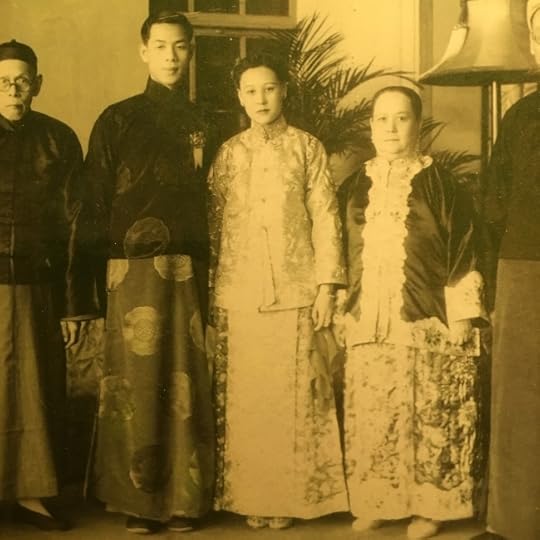
The author’s grandfather on his wedding day
My grandfather heard the rhythmic beat of a gong closing in on his village. Before long, another sound could be heard: the shuffling of feet. Dozens of feet pounding and stirring the dirt.
The sound of the gong and the feet filled the village streets. Creeping out from their hiding spot, my grandfather and his brother inched over to the window and peeked out.
They saw a line of corpses, lurching, hopping, swaying through the streets, to the beat of the gong. They saw white cloths covering the heads of the dead, faces positioned up and forward, supposedly looking toward their final resting place.
They saw Taoist priests “herding” the dead, keeping them in line; one brought up the rear, a couple flanked either side of the line, one was the leader of the procession, and one walked ahead beating the gong.
As the dead passed through, my grandfather and his brother, while curious, made sure to never stare directly at the corpses. It was said that if the living looked too hard at the dead in such a procession, that the corpse might latch onto that person and try to steal their energy or “Chi”.
Grandfather told of a girl who did not heed this warning, and stared too long at a passing corpse. The corpse became enamored of her, tried to make her his “Ghost Bride”, dragging himself toward her, reaching for her. The priests had to surround the corpse and say prayers over him for many hours before he would leave the girl and get back in line.
So the story goes anyway. It seems that every village had a similar tale.
Eventually the dead passed through my grandfather’s village, with all living souls left safe and sound to live another day. Life in the village returned to normal, and nobody spoke much of THE NIGHT OF THE HOPPING DEAD.
While it was not something to be ignored, it was just understood that these things do happen. Sometimes the dead process through your village in the middle of the night. Just behave yourself, don’t stare, and shut your mouth. What of it?
But what did my grandfather actually see?
For his entire life, this was his only “spooky story”, one that he adamantly maintained was true. Skeptical, stoic, and reserved, he swore that he did not see ghosts or spirits or demons that night, he saw the walking (hopping) dead.
While it would be easy to write off my grandfather’s story as just one of old-world superstition or even a child’s nightmare, as it turns out there may be more than a little truth behind what my grandfather saw almost 100 years ago in Guangzhou.
No, I’m not saying that my grandfather saw a line of corpses reanimated by the power of prayer parading down the main street of his village. But what I am saying is that maybe my grandfather saw what was meant to trick people into thinking they were seeing a line of corpses reanimated by the power of prayer.

SAIGON 1960s – Chinese Funeral Procession musicians by manhhai, via Flickr/Creative Commons License https://creativecommons.org/licenses/...
For almost as long as there have been dead people in China (so a long time) it’s been believed that that a person’s journey does not end in death. When a person dies they must return to the soil from whence they came. It didn’t matter if a person died 10 miles or 10,000 miles from their birth dirt, their body had to get back there. If a person was not properly buried in their home soil, family and friends risked having an angry, wandering spirit on their hands.
But getting a corpse back home wasn’t always easy. Transport by train or car could be very expensive. So obviously the only option was to have the corpse carry itself home.
This could be accomplished in two general ways: either by herding a corpse or walking a corpse.
The first practice of “herding” or driving a bunch of corpses involved assembling a number of corpses that needed to be delivered to a specific village or region. Taoist priests (or people calling themselves Taoist priests) would begin by praying and chanting over the dead so as to “possess” them into walking.
Much of this was for show, so that people would believe that yes, the corpses were actually being reanimated, and yes, they should keep their distance. It was all part of setting the stage for a swift, uninterrupted transport of the dead. Not to mention it only added to the priests’ status and AURA OF MYSTERY if people believed they actually had powers over corpses.
In a single file line, corpses would be tied to bamboo poles, one on either side of their upright bodies. Then, the ends of each pole would be hoisted onto the shoulders of a man at the front of the line, and a man at the back of the line, and off they would go.
As the men walked with the poles on their shoulders, it appeared as if the dead were shimmying, shaking, and hopping along on their own. A priest would head up the front of the procession and ring a bell or beat a gong in order to warn people of the coming dead.
This gave folks a chance to hide themselves or look away, as encountering the dead in Chinese belief is bad luck. Plus there was also the whole “steal your Chi/be my Ghost Bride” thing to contend with.
Conveniently, with everyone cowering and averting their eyes, nobody would get a good look at how the dead were moving. Add in the fact that the priests typically moved the corpses in cold weather and in the middle of the night, and you have a perfect recipe for speedy travel devoid of gawkers and maximum urban legend payoff.
If you know your audience, and shroud your activities in a thick layer of plausible superstition, you too could move the dead!
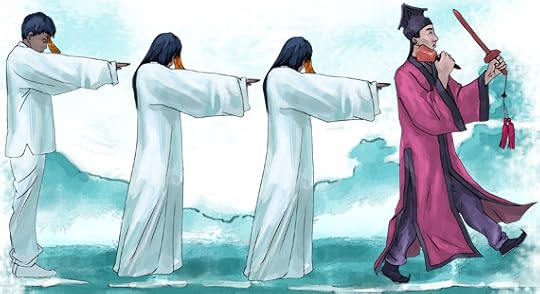
It’s very likely that my grandfather saw this sort of “herding” procession of corpses. He may have absolutely seen the dead making their way home, perhaps just not in the magical way he suspected.
Another way to move the dead would be via a corpse walker.
Corpse walkers were people whose job was to literally walk dead bodies home. While it is hard to find official records of “professional corpse walkers”, this business has been a part of Chinese culture for hundreds of years. As recently as the mid 20th century, there were reports of corpse walkers in China.
Like the herding of corpses, the details of corpse walking hide partly behind superstition.
When a corpse had to return home, a corpse walker was charged with “magically” reanimating the corpse and guiding it to its grave. People tell of seeing a corpse, dressed in a long black robe, obediently trudging behind a corpse walker.
The corpse walker carried a white paper lantern and a basket of fake money that he intermittently showered upon the ground ahead of the corpse. This was to bribe the deceased’s way into the next life, known as “buying your way into the other world”. As the corpse walker marched onward, he chanted something like, “Yo ho, yo ho” mixing in directions for the corpse following him.
The corpse itself loomed large, its head covered, its face beneath a mask. Everywhere the corpse walker went, the corpse was sure to follow.
People avoided the walking corpses and the corpse walkers in much the same way they avoided the herded corpses, keeping the corpse walkers’ secrets properly protected.
But what were those secrets?
While necromancy and folk know-how were part of the mystique of the corpse walker – author Liao Yiwu talks of having a black cat walk over a corpse “generating static electricity that would make the corpse move like a puppet” – the act of walking the dead was surprisingly simple.
Corpse walkers worked in pairs. One was the leader, the “walker”, one had the corpse hoisted upon his back, he was the “carrier”. The carrier’s job was also to masquerade as the corpse. Since the corpses were very heavy, and the walkers often had to travel for months at a time, the pair would regularly trade off who had to carry the corpse. The weight of a corpse on the corpse carrier also accounted for what appeared to be the corpse’s stiff gate.
Because the corpse carrier was hidden under the long, dark robe covering both him and the corpse, he used the corpse walker’s lantern – day or night – to guide him. To keep the corpse as fresh as possible, the corpse walkers only travelled during winter months, and put mercury into the corpse’s orifices to fend of decay.
For most of China’s history, it seems that corpse walking was a good way for an able-bodied person to earn money. It wasn’t until the rise of Chairman Mao and the Communist Party of China that corpse walkers became seen as “counterrevolutionaries” or “engaging in superstitious activities” and could face severe punishment, even death. Liao Yiwu writes of a pair of corpse walking brothers reported to the People’s Liberation Army who were arrested and jailed (in the same cell as the corpse they were meant to walk).
During an escape attempt, one brother was killed. The surviving brother buried him and was sent back to their home with only a death certificate. Sadly, there was no corpse walker for the corpse walker.
While corpse walkers may not have always been the most upstanding members of society (corpse walking was sometimes connected to smuggling or other unsavory practices), it was an accepted profession. Corpse walkers did what others couldn’t or wouldn’t do.
Corpse walkers and corpse herding priests provided a service. They let the living put what felt like a safe distance between themselves and the dead. Concealed beneath a warm cloak of superstition, the corpse walkers and corpse herders allowed people to focus on the mourning or spiritual aspects of death, instead of the cold reality of corpse transportation.
And really, the theater that the corpse transporters provided was just as valuable as the actual transportation. They made death and what happens to you after you die a thrilling, chilling part of the cultural conversation.
Sometimes the dead would walk through your village, that’s just how things worked. You paid them their due, you behaved with respect, but at the end of the night, it was only death passing through, and you’d live to see another day.
Louise Hung is an American writer living in Japan. You may remember her from xoJane’s Creepy Corner, Global Comment, or from one of her many articles on death, folklore, or cats floating around the Internet. Follow her on Twitter @LouiseHung1
Resources
The Corpse Walker: Real-Life Stories, China from the Bottom Up by Liao Yiwu, translated from the Chinese by Wen Huang
The World of Chinese Magazine, “The Real Walking Dead” by Weijing Zhu
January 26, 2017
DUDE, Your Mannequin is a Corpse
Caitlin Doughty's Blog
- Caitlin Doughty's profile
- 8410 followers



